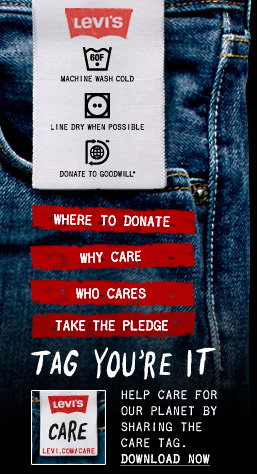


For more than 155 years, Levis Strauss & Co. has been a pioneer – both in our original clothes and by leading with our values.
As a company, we are committed to building sustainability into everything we do, so that our profitable growth helps restore the environment.
| • | We were the first in the industry to set labor and environmental requirements for partners who create our clothes. |
| • | We have been leaders on setting standards for water quality in our manufacturing locations. |
| • | We're committed to achieving carbon neutrality by reducing our energy consumption and moving to the use of 100 percent renewable energy. |
| • | We have reduced our water consumption and carbon emissions. |
| • | We are working to use our global influence to make the cotton industry more sustainable, not only for the cotton used in our products, but for cotton farms around the world. |
But our research shows that it’s just as important to ask you to join this conversation as there’s a significant environmental impact that happens after you take your clothes home the store.

Our lifecycle assessment of Levi's® 501 jeans and Dockers® Original Khakis showed that the greatest opportunity for improving environmental sustainability exists once you’ve taken them home. Simple care and recycling guidelines can go a long way toward reducing climate change impact. Wear responsibly and help us reduce the environmental impact of the clothes you love to wear.
Here’s what you can do to help reduce the climate impact of your clothes and keep them out of landfills:
| 1. | Wash your jeans in cold water. You can significantly reduce the impact of your clothes on the environment by taking a simple step: wash them in cold water instead of warm or hot. |
| 2. | Wash your jeans less. By washing your jeans once every two weeks instead of once a week, you can decrease your overall climate change impact of washing those jeans by almost a third. |
| 3. | Line-dry your jeans. You can reduce the full lifecycle climate change impact of your jeans by up to 50 percent by line drying and washing them in cold water. |
| 4. | Donate your used jeans. Many of our retail locations have bins for donating your old jeans – or you can find a Goodwill location near you. We’re also piloting projects in which we recycle old jeans to use as building insulation and other materials. |
Sustainability is a global issue with an impact in every country and every community. By following these simple care instructions, you can help make a big difference in reducing the footprint of your clothes.

| • | The average person in the US throws away 68 pounds of clothing and textiles a year. |
| • | Almost half of the water that is used throughout the life of a pair of jeans takes place after you bring them home from the store. |
| • | Throughout its lifecycle, a pair of jeans consumes as much energy as powering a personal computer for 556 hours. You can reduce this by washing less and line drying when possible. |